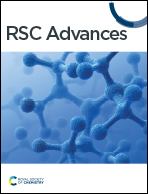Cobalt-doped zinc oxide based memristors with nociceptor characteristics for bio-inspired technology†
Abstract
Neuromorphic computing is a new field of information technology, which is inspired by the biomimetic properties of the memristor as an electronic synapse and neuron. If there are electronic receptors that can transmit exterior impulses to the internal nervous system, then the use of memristors can be expanded to artificial nerves. In this study, a layer type memristor is used to build an artificial nociceptor in a very feasible and straightforward manner. An artificial nociceptor is demonstrated here through the fabrication and characterization of a cobalt-doped zinc oxide (CZO)/Au based memristor. In order to increase threshold switching performance, the surface effects of the CZO layer are eliminated by adding cobalt cobalt-doped zinc oxide (CZO) layer between the P++-Si and Au electrodes. Allodynia, hyperalgesia, threshold, and relaxation are the four distinct nociceptive behaviours that the device displays based on the strength, rate of relapse, and duration of the external stimuli. The electrons that are trapped in or released from the CZO layer's traps are responsible for these nociceptive behaviours. A multipurpose nociceptor performance is produced by this type of CZO-based device, which is crucial for artificial intelligence system applications such as neural integrated devices with nanometer-sized characteristics.



 Please wait while we load your content...
Please wait while we load your content...